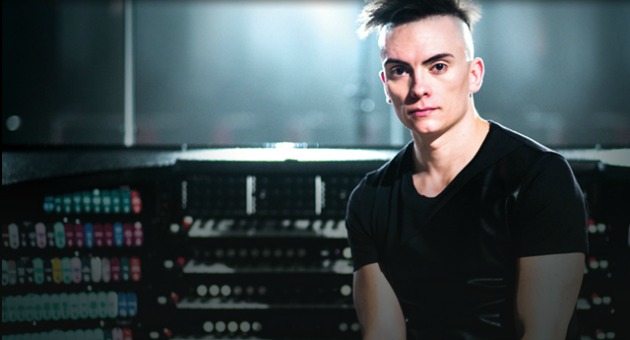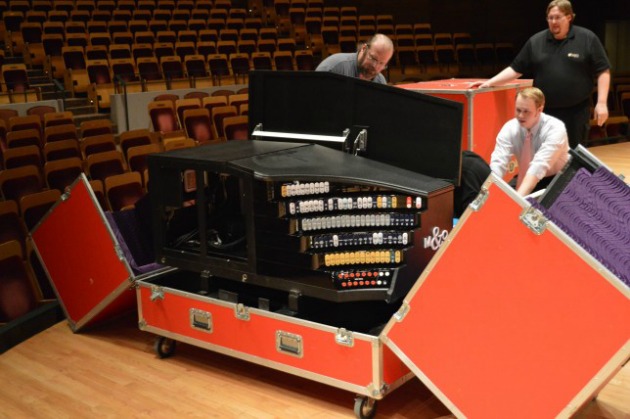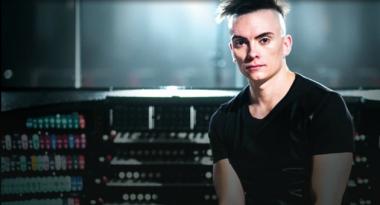
Cameron Carpenter isn’t traveling light this time.
When he flew into San Francisco International Airport from his adopted hometown of Berlin in 2014, it was to perform Harry Brant’s Ice Field with the San Francisco Symphony, on Davies Hall’s resident Ruffatti pipe organ. Earlier that year he’d played a sold-out organ concert on Grace Cathedral’s Aeolian-Skinner. “They’re both great organs, and they’re local institutions,” Carpenter had commented to SFCV. “But organs are as temporal as everything else.”
This time, the 34-year-old organist is traveling with what he estimates as “16 tons of highly specialized, modular equipment.” That’s what will allow him to showcase, in four performances next week, and for the first time on the West Coast, his self-designed International Touring Organ. In a two-hour load-in at the SFJAZZ Center’s Miner Auditorium next Thursday, Carpenter and his crew of five will install what’s arguably “one of the most evolved consoles ever” — five manuals (keyboards), a specialized pedalboard, and controls for the stops. There’ll also be a supercomputer/amplifier unit, the brains of the array, and an expansive proprietary system of specialized speakers. But no pipes.
The computerized programming of the Touring Organ delivers what’s in essence a digitized synthesis of the sounds of Carpenter’s favorite pipe and electronic organs, encountered since he was a six-year-old in a church in Erie, Pennsylvania, and in all his subsequent student and professional performances. “A great organ should be American,” says Carpenter, “at least in the traditional way that we think of America as a melting pot.”
Carpenter’s repertoire on his digital instrument, heard elsewhere in the U.S., in Europe, and on his debut Sony recording, has been similarly eclectic, ranging from his arrangements of classical and pop material to his own, airy, original compositions. The Touring Organ inevitably elicits skepticism and envy alongside praise, but Carpenter’s virtuosity is undeniable. “I’ve had very high regard for him,” testifies Paul Jacobs, chair of Juilliard’s organ department and Carpenter’s former teacher. “We’re of quite different temperaments and on some levels have different objectives, but we both are united in broadening the audience for organ music.”
“I have a problem with being limited to a physically immobile instrument,” says Carpenter about the motivation behind his creation. “The pipe organ has had its time, and if the organist’s time is not also past, then the organist has to be mobile. It’s regressive to try to pretend that the only organ is the pipe organ.” With an ear to enlarging his audience as well as his repertoire, Carpenter’s sound design has also incorporated qualities of theater organs along with those associated with the church.

“I’ve always thought of the organ as like a great city,” he posits. “Think of Berlin, for instance: It has great neighborhoods, with churches and embassies and shops, but it also has seedy neighborhoods with sex shops, gay saunas, and places where you can buy drugs. And everything in between. It has a massive underground, great foundations, and staggering heights. And all these things are appropriate and desirable, and needed in a great organ.” “I’ve always thought of the organ as like a great city,” -- Cameron Carpenter
The son of an inventor holding many patents, Carpenter also regards his instrument and its “self-referential” digital design as “an open laboratory, which at any time can develop, change, alter anything, and immediately switch it back. Any time the organ is turned on, what’s played at that time is logged, and we can experiment with any aspect of functionality.”
By way of example, Carpenter notes that before recording his about-to-be-released second Sony album, titled All You Need Is Bach, “We developed a way that the organ can be transpositionally retempered to the key of every work, opening up acoustic and listening experiences that would literally have been physically impossible.”
Since the 2014 debut of the Touring Organ, built by Massachusetts-based Marshall & Ogletree, Carpenter has “sampled and added many, many new stops and many, many new sounds.” The instrument is now “rougher, and I mean that in the sense of the roughness of nature, which is very difficult to develop in digital instruments, because they tend to strive toward perfection. I want an organ that unabashedly has shocking, vulgar, and sometimes downright ugly sounds available.”
But there has also been “an enormous effort with some of the mixture stops, which give the organ its upward architectural development and make it obvious that the organ is a physical incarnation of the harmonic series itself. And these stops are important in the performance of Baroque organ music.”
“I haven’t played much from the Romantic era in America lately, but I’ll be playing from [Louis] Vierne,” Carpenter continues. “I’m playing three of his incredible Pièces de fantasie, including one very dear to my heart, because it deals with Greek mythological figures, the Naiads. I’m always happy to point out, when people trot out the totally inaccurate adage that the organ comes from the church, that it doesn’t have to be from a Christian god. It should be polytheistic, since it originated in ancient Greece in the form of the hydraulos [a water-powered organ]. It would have to be said to be the instrument of many gods!”
In a similar spirit, Carpenter likes to envision both his instrument and himself as androgynous, and his wardrobe and hairstyle have been the source of additional delights in live performances. “I know I have some Alexander McQueen stuff I’m going to be wearing,” he announces, “but I’m not going to change after every piece.”
There’ll also be pre-concert talks by Carpenter, an hour-and-a-half before evening performances, presented in partnership with the Aspen Institute, for whom the organist will serve as artist-in-residence this summer. The onstage conversations will include Aspen director Damian Woetzel and 14-year-old, blind, organ prodigy Matthew Whitaker. “I’m trying to develop a system there whereby children, and particularly underprivileged kids, are given the chance to play the Touring Organ, and to understand what an instrument is,” says Carpenter, quickly adding, “Not because I’m trying to make them organists, but because I believe that, as a self-referential, closed system, the organ has the ability to open minds and make synaptic things happen. Particularly young minds.”
Young Woetzel will be the first-ever person other than Carpenter to perform publicly on the Touring Organ.

